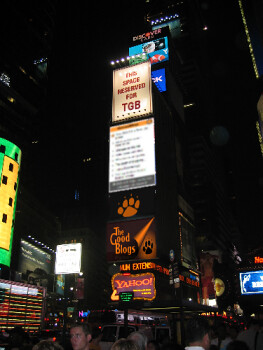Haydn, over at
TheMediangler always has some thought- provoking insight into the state of the Internet. I wanted to combine his recent post on
where content was going with what we are achieving at TheGoodBlogs. Blog aggregators, like search engines, are great in what they do but getting exposure is the issue. One might argue that as blog aggregators grow, they are not unlike search engines except they control a small pool of contributors in the interests of quality. Ergo, the issue is always about quality vs volume. At some point, to be successful, they will have to grow and volume will affect quality and reintroduce the concept of the long tail.
TheGoodBlogs is based on the premise that the long tail exists in part because of exposure. The growth of the Internet and the billions of content pages in all its wild and chaotic state means that most content (good or bad) are never seen. How many RSS feeds can you read in a day? How many newspapers do you subscribe to? You get the picture...if not the blog :). The limiting factor is time and not enough of it. TheGoodBlogs doesn't replace your search engine or your blog aggregator but it is network based promotor of blogs. As the blogger billboard on every blog, we are able to introduce new bloggers to readers in a very convenient and unintrusive way. Convenience is perhaps a good word to describe us. It doesn't require a reader to search Google or Yahoo and doesn't require the reader to visit their blog aggregator or read a long aggregated feed. It's there if you have time and the interest.
The best part is the success of the network is up to the members, the more members, the more diversity and readers the bring to the network solving the issue of scalability and bloggers being pushed into obscurity by volume. In the two months since we started our private beta, we have promoted our bloggers close to a million times! (Janet Jackson's
what have you done for me lately! comes to mind)Getting readers to click through is not in our control, it is up to the blogger to place us in a spot that is seen by his/her readers and to have titles that are compelling. "Links of the day" may not be as compelling as "Google crushes YouTube!" (example only!). It would be hard for any blogger to argue that being part of the a million exposures is a bad thing especially when they need to no work and pay no money.
Time will tell whether TheGoodBlogs will live up its promise. We are encouraged because we do hear comments from our members that their readership and activity on their blogs have increased. Many bloggers themselves find it convenient to see new content on their very own pages. It is their very own random RSS aggregator right on their own blog!
So what is TheGoodBlogs? perhaps we are the napster of blog aggregators. For bloggers, it is about blog promotion. For readers, it is about blog discovery. For us, it is about creating a company that may impact and change the blogosphere even if it is in a very small way. No man or blogger need be an island anymore.
BTW: for TGB members, you'll notice a slightly new look to the widget on this blog, the cleaner and newer look will be available to all members shortly. Yeah, I know, many of you hate orange but as my son would say, "But I made you look, didn't I!". Honestly, we don't intend being the ugly duckling of the Internet so stay tuned as we become one with your good blogs!



















